Kicking off the campaign period: Admin-backed senatorial candidates receive more TV news mileage
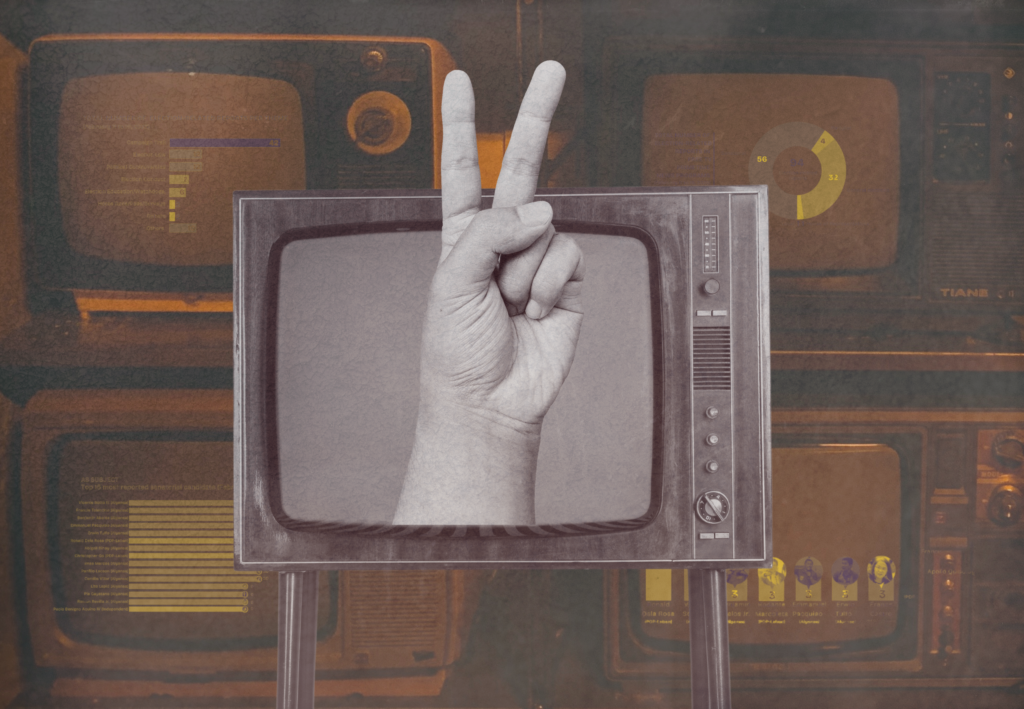
THE OFFICIAL campaign period kicked off on February 11 for the May 2025 midterm elections with 66 senatorial candidates and 156 party-list groups vying for seats in Congress. Different parties and alliances held proclamation rallies to present their political platforms, introducing old and new faces, and familiar and not to familiar family names.
Independent candidates Paolo Benigno “Bam” Aquino IV and Francisco “Kiko” Pangilinan chose Cavite to start off their campaigns on February 11. On the same day in Manila, the progressive Makabayan presented their slate of candidates at at Kartilya ng Katipunan in Manila on the same day. The Makabayan lineup includes Jerome Adonis, Jocelyn Andamo, Ronnel Arambulo, Arlene Brosas, Teddy Casiño, France Castro, Mimi Domingo, Mody Floranda, Amirah Lidasan, Liza Maza, and Danilo Ramos.
On the same day, President Ferdinand Marcos Jr. himself presented the administration-backed Alyansa Para sa Bagong Pilipinas in his home province, Ilocos Norte and then flew to Iloilo City to do the same on February 13. Senatorial slate holders include Abigail “Abby” Binay, Benjamin “Benhur” Abalos, Panfilo “Ping” Lacson, Vicente “Tito” Sotto III, Emmanuel “Manny” Pacquiao, Francis Tolentino, Erwin Tulfo, and Camille Villar.
Former President Rodrigo Duterte on February 13 did the honors as chairman of the Partido Demokratiko Pilipino-Lakas ng Bayan (PDP-Laban), presenting the party’s senatorial candidates: Jimmy Bondoc, Ronald “Bato” Dela Rosa, Christopher “Bong” Go, Jesus Hinlo Jr., Raul Lambino, Rodante Marcoleta, Pastor Apollo Quiboloy, and Philip Salvador, and guest candidate Vic Rodriguez.
The Bantayog ng mga Bayani in Quezon City was the site of the Partido Lakas ng Masa campaign rally on February 16, proclaiming two senatorial candidates, Leody de Guzman and Luke Espiritu as the senatorial candidates.
First week of 2025 campaign
CMFR reviewed free TV primetime news programs GMA-7’s 24 Oras, ABS-CBN’s TV Patrol, TV5’s Frontline Pilipinas, and NewsWatchPlus’ NewsWatch Now (no weekend news program) from February 11 to 16, 2025 – the first week of the campaign period. Each news program featured special segments the election coverage: Eleksyon 2025 (24 Oras), Halalan 2025 (TV Patrol), Bilang Pilipino 2025 (Frontline Pilipinas), and Vote Watch 2025 (NewsWatch Now).
The three aired a total of 94 election-related stories, the bulk of which focused on campaign sorties and launch events for senatorial tickets. There was limited coverage of the Party-list campaigns.
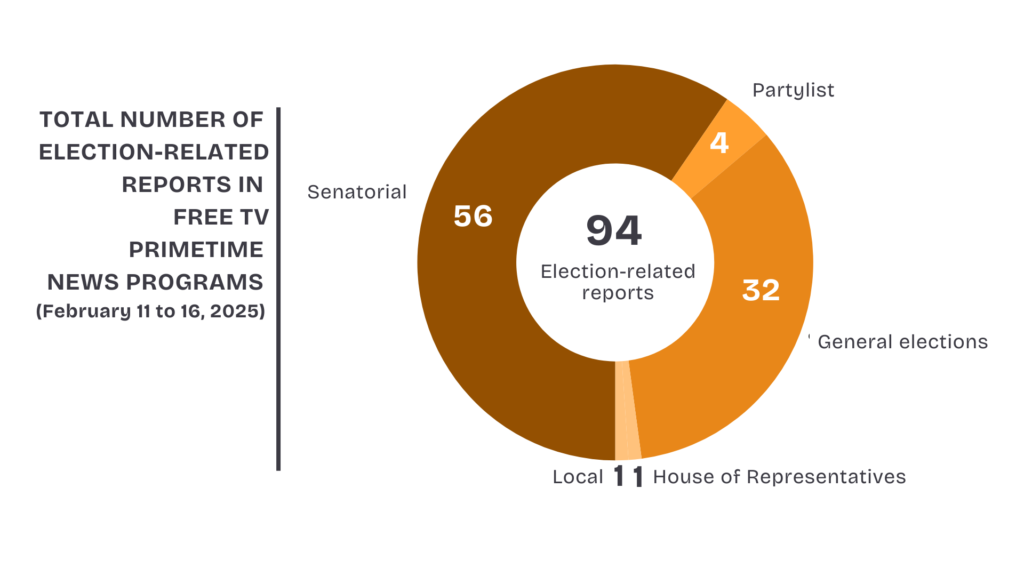
Senatorial campaigns dominate news coverage
Primetime news coverage did the usual, keeping close to the campaign events. Reports focused on the candidates, highlighting the location of the event, identifying those who were present, and the persons who were endorsing the candidacies. Coverage limited the footage cut from speeches, providing brief notes on platforms and promises.
Subjects and Issues covered in reports
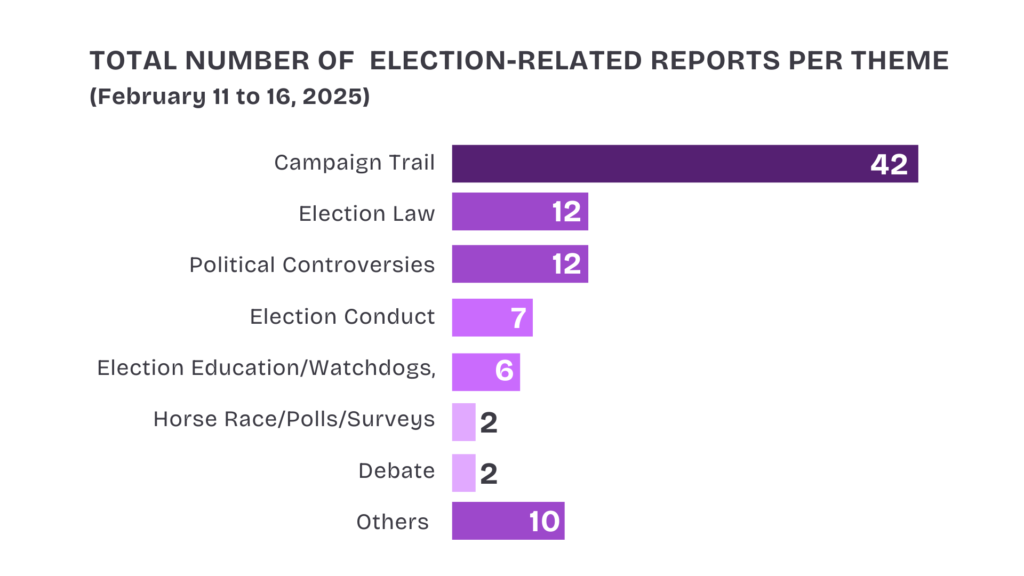
Other Election-Related Reports
Coverage included election laws, such as campaign regulations and Oplan Baklas, the actual preparation for elections, such as the ongoing ballot verification.
Reports highlighted KontraDaya’s findings that 55.31 percent of partylist groups did not represent marginalized sectors.
Media picked up political controversies, particularly the tension between Duterte and Marcos Jr, highlighting remarks made by either one. On February 11, Marcos Jr. stated that his candidates had “no blood on their hands,” an obvious jab at PDP-Laban politicians linked to Duterte’s war on drugs. For his part, Duterte, in a February 13 speech, called Marcos “bangag” (stoned), accusing the president again of addiction.
Admin-Backed Candidates Dominate Media Coverage
Media’s custom to give more prominence to the already prominent was in full practice. Candidates from well-funded parties received the most exposure. Primetime news heavily featured traditional political figures who are already well known; while alternative candidates and grassroots movements received little to no airtime.
The administration-backed Alyansa, which held two major rallies during the period, garnered the most media mileage. All 12 Alyansa candidates ranked among the top 15 in terms of news visibility:
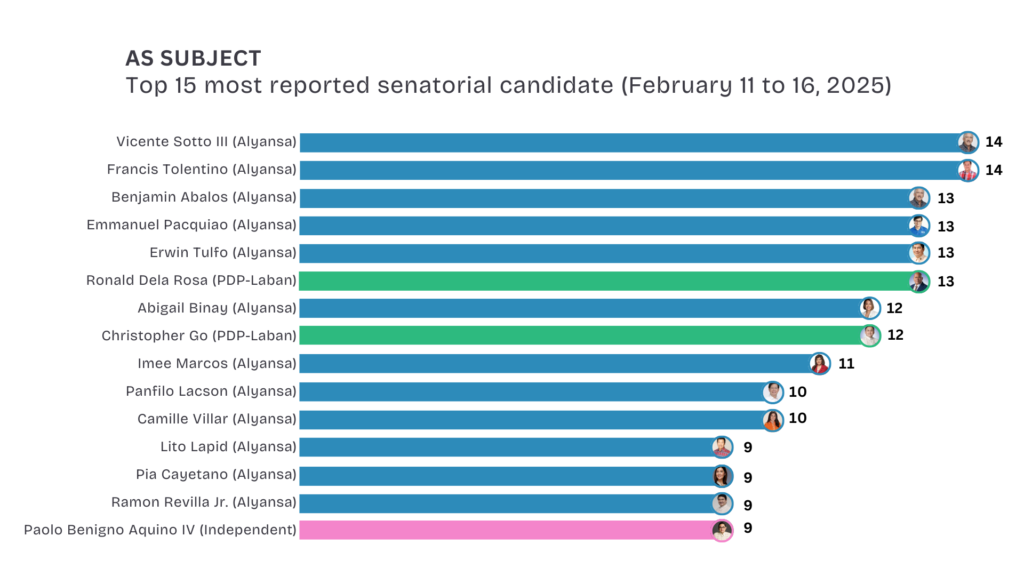
Meanwhile, PDP-Laban’s Dela Rosa was the most frequently quoted in the reports. His controversial remarks urging voters to support all PDP-Laban candidates to prevent Vice President Sara Duterte’s impeachment, his expression of pride for the role he played in the conduct of Duterte’s war on drugs, and his declaration of readiness to go to war with China – all received ample air time.
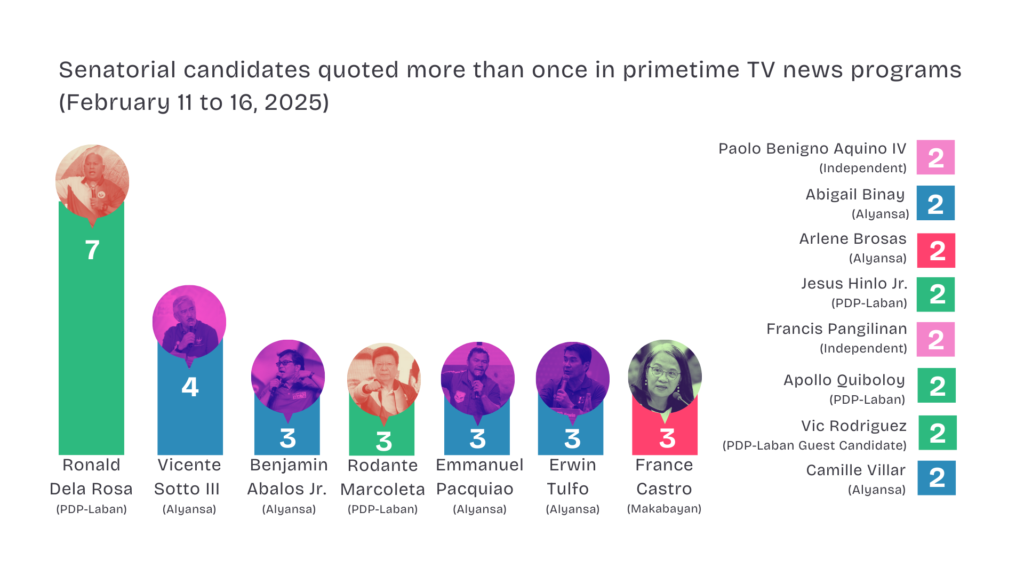
Visibility of one’s campaign activities and events is crucial to a candidate’s chance of winning. Media exposure shapes public perception, providing the visual elements of the candidate’s personality, even the character, not to speak, vital information about their record of public service and the policies they advocate. These build the foundation of public perception regarding the worthiness of a person seeking public office. Candidates with high visibility can effectively communicate their platforms, while those with limited coverage struggle to gain exposure and access to a larger audience.
Media exposure is driven by newsworthiness (events, color or human interest, even drama) elements that must be strategically spread through the campaign period to keep both candidate and his message in the public mind. Persistent and consistent exposure must follow up to retain early gains.
But media must guard against gimmicks and persuasive mechanisms. Journalists must provide newsworthy information that helps voters evaluate candidates through the entire campaign period. Campaign coverage must be alert to the inconsistencies displayed by the candidates’ words and actions. Journalists should not rely entirely on campaign managers provide as these are all designed to make candidates look good.
Social media can be applied to make up for the lack of abundant funds for traditional campaign inputs, posters, campaign rallies, and door-to-door visits. But it can also be weaponized by well-oiled campaign machineries as we have seen in the past elections. Legacy media still holds tremendous resources for keeping a name in the public mind or creating space in the public consciousness. Traditional media, particularly television, can help level the playing field by the conscious distribution of time and space to the names worthy of consideration, who may lack resources but hold impressive credentials in promoting the public good.
Based on straightforward knowledge about public service records of a candidate in or out of government, media managers and gatekeepers can and should measure out as much of the time and space to make better candidates known to voters. Media should look around and check how they can help citizens choose better and more wisely this coming election. Start with getting to know the candidates, checking individual records of performance, contributions made to public good and social welfare, policy votes on the right side of issues – such information help voters evaluate those presenting themselves for public office. Media reports during the campaign period should focus on these matters so deserving candidates can be better known.
Recommendations for Covering the Elections
Media coverage always plays a vital role in informing voters about candidates, their platforms, and key election issues. By ensuring balanced, factual, and in-depth reporting, the media empowers citizens to make informed decisions and holds political players accountable – and this takes more than just following a campaign sortie.
These recommendations were made after the 2022 elections in solidarity with much of the media community’s commitment to enhancing public awareness and understanding of election issues and electoral processes.
On campaign and election reporting
- Provide articles and analyses on the backgrounds and track records of candidates once they declare their intention for public office.
- Recall these records and amplify them as the campaign proceeds so voters can bear these in mind as campaign proceeds, particularly as election day nears. This is already being done but the practice should be enhanced.
- Minimize coverage of the campaign trail; heighten the focus on the electorate instead, particularly the voiceless and the marginalized by:
- Identifying the issues of concern of various sectors that candidates should address
- Evaluating and fact checking candidates’ claims as to their veracity and the possibility of their addressing these concerns
Focus on the following:
- Enhanced coverage of campaign fund sources to include investigative reports on the biggest contributors backing which candidates, helping voters to check the political and economic interests at play;
- Make social media and blogs a regular beat, reporting, reviewing and verifying the claims of bloggers and other online influencers;
- Provide more interpretive news: Remind reporters of the need not only to report the facts but also to evaluate the significance of the information provided and what these mean for Philippine society as a whole.
Between campaign/election seasons
The news community must not limit the discussion of elections to campaign and election periods. The value of news is based on its contribution to citizenship and its responsibilities. Journalists, editors and reporters, must discuss how well the news content they provide equip citizens to fulfill the duty of voting and choosing leaders wisely. The following are suggested so the news community can find ways of improving the way they do their job:
- Election reporting must be ongoing. Journalists should not wait for the next electoral season to report on the amendments that are needed in the electoral law.
- Begin reporting on the need to revise and update election law.
- Among other issues, review and discuss the following:
- The qualifications set for candidates for certain posts.
- Discuss the need to address the problem of of “premature campaigning”
- Review the need and value of a “run-off” vote.
- Engage more closely with the academe to discuss the need for reform, including amendment of laws that journalists have come to identify as problematic. The interdisciplinary outlook will deepen the appreciation for electoral reform, promote greater media literacy and develop stronger discourse about these issues.
- Review the news conventions as taught in journalism courses to test the validity of “objectivity” and “just the facts,” among others, as a basis for newsgathering in the current news and political environment.
ALSO SEE SIDEBAR: “Hardly anything new: Print, online stick to the familiar campaign trail“
Leave a Reply